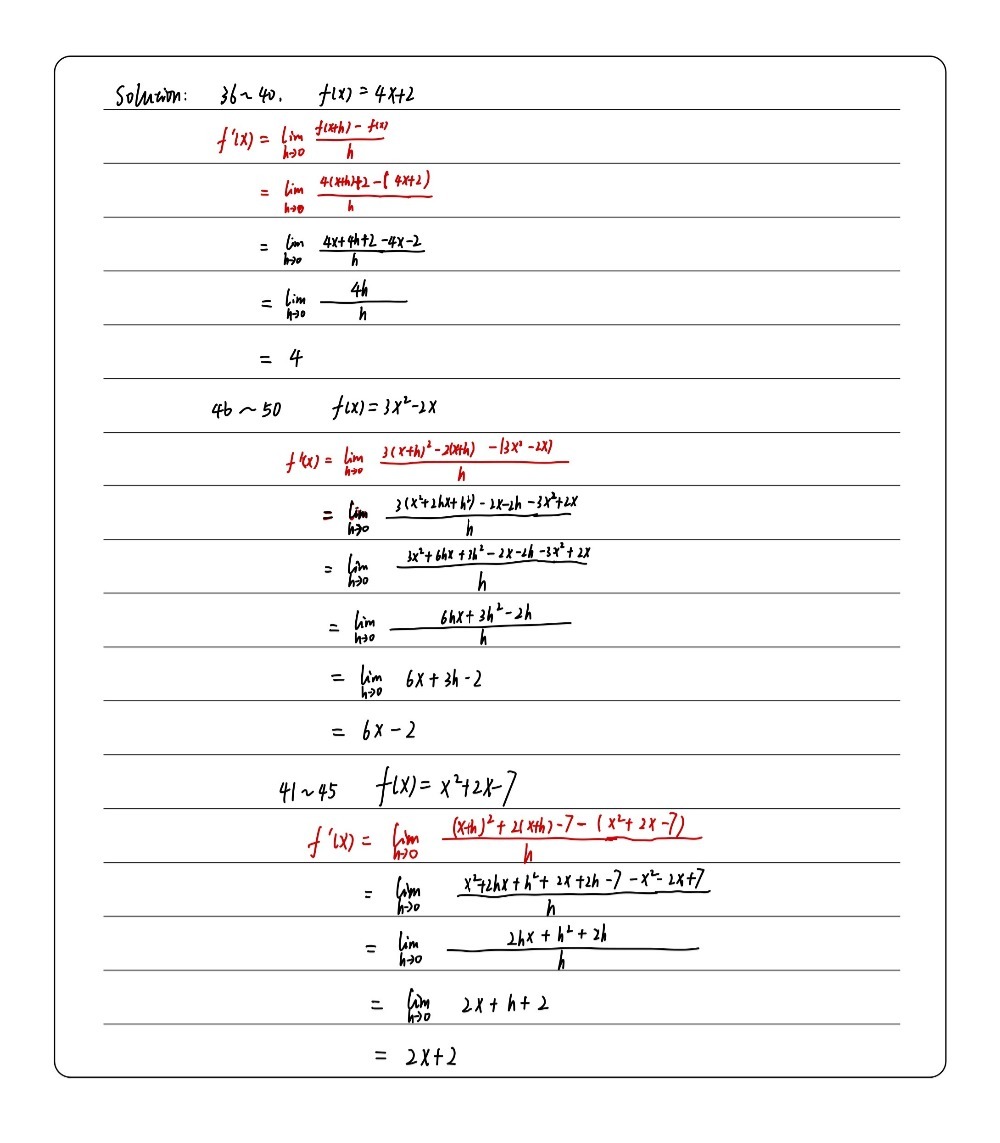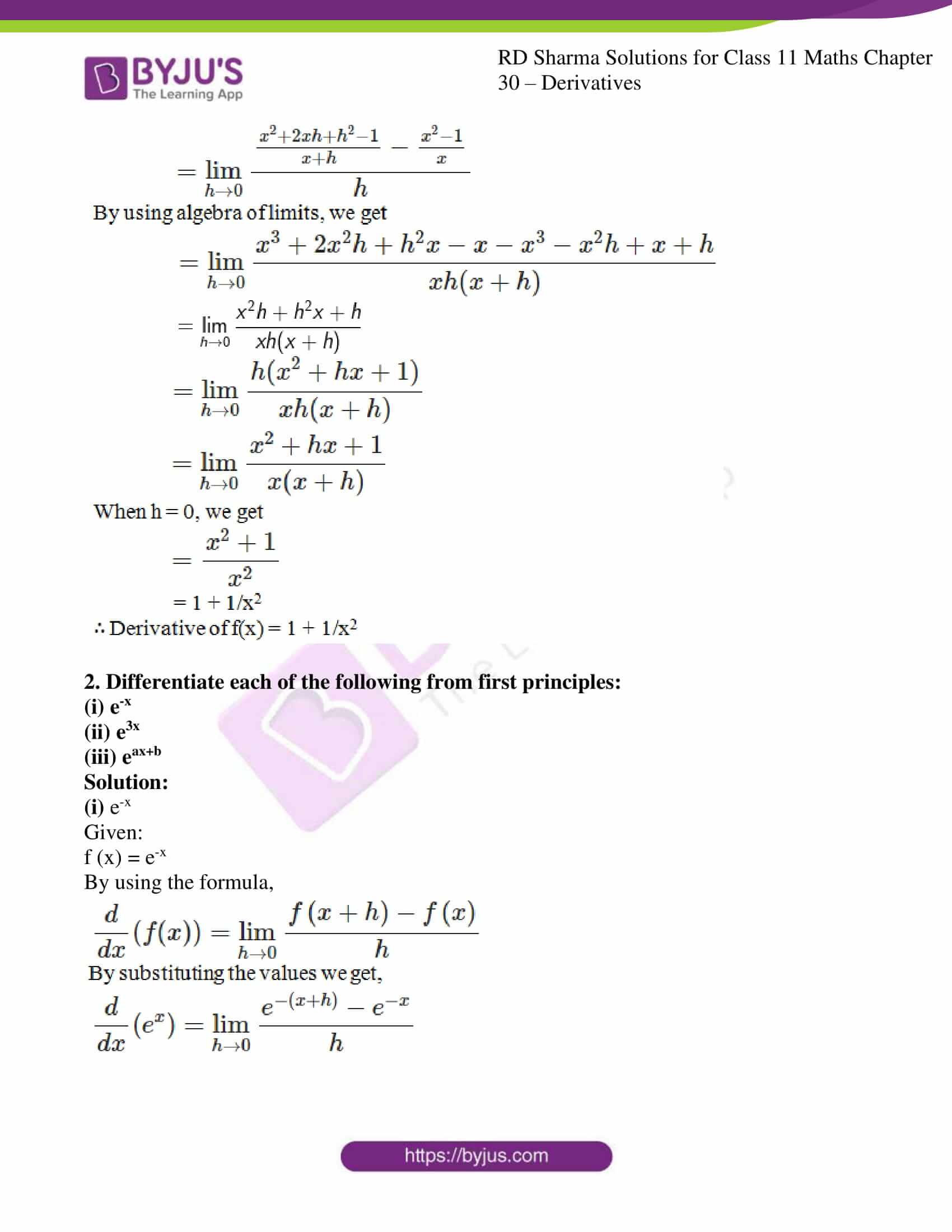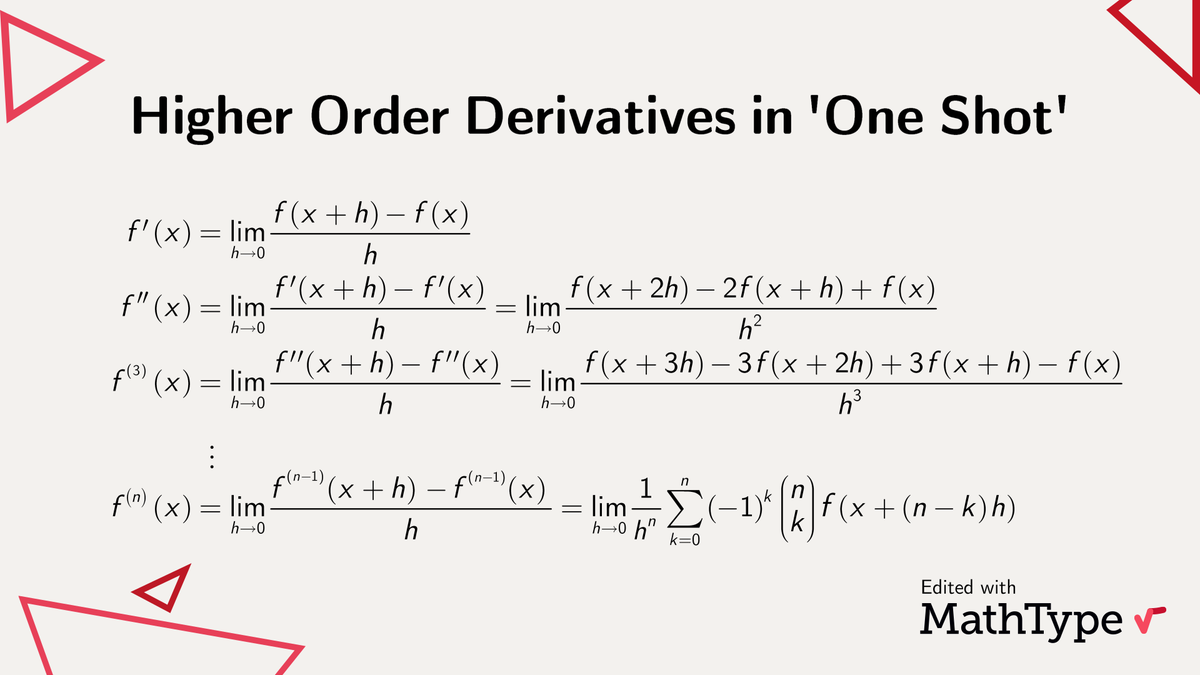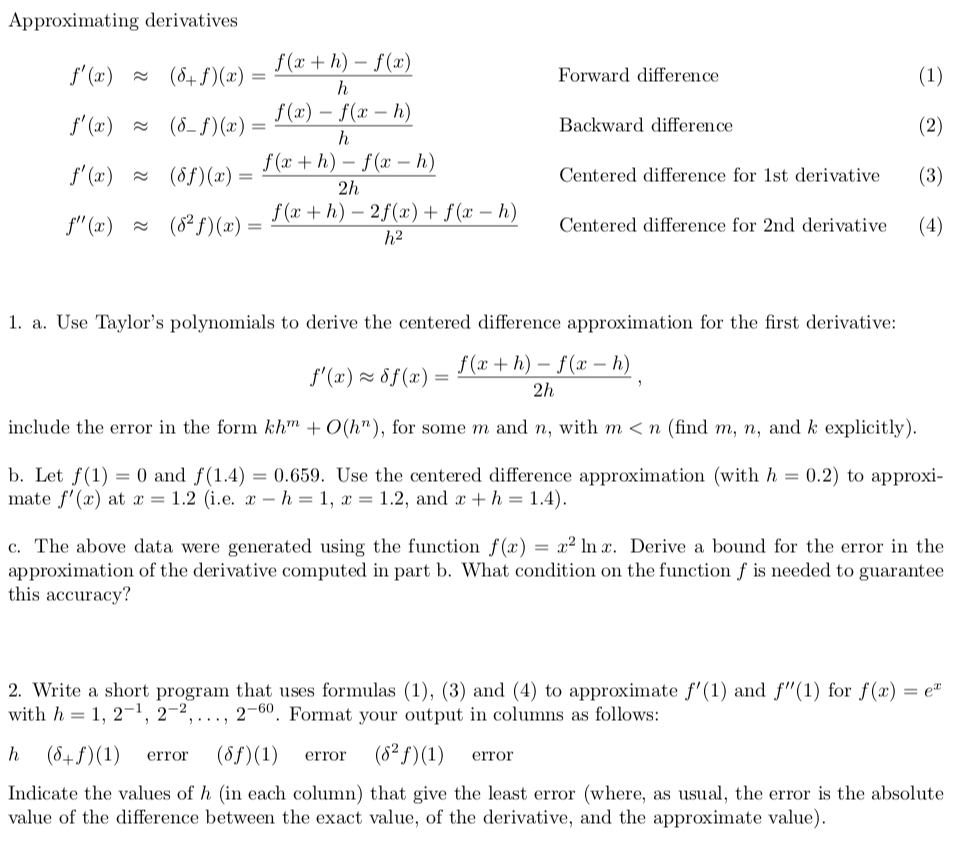Find the derivative of the function f(x) = x x 5 using the limit de nition of the derivative Note the format of the solution below It is important to carry the limits and show all calculations in order to recieve full credit f0(x) = lim h!0 f(x h) f(x) h = lim h!0 xh xh 5 x x 5 h = lim h!0 (x h)(x 5) x(x hThe square function given by f(x) = x2 is differentiable at x = 3, and its derivative there is 6 This result is established by calculating the limit as h approaches zero of the difference quotient of f(3)Business Finance Derivative (finance) Use f' (x) = limit as h approaches 0 of (f (x h) f (x))/ (h) to find the derivative at x for the

Ii Deterrmine The Derivatives Of The Functions Us Gauthmath
What does h mean in derivative formula
What does h mean in derivative formula-Transcribed image text For the function f(x)=x²3x1 a) Find the derivative f'(x) by using the definition f'(x) = lim f(xh)f(x) h 10 (xh) 2 3(xh)(x23x1) h tha2xh 3x 3h2 30 4 h hat 3x2xK h 2x3 b) Find the slope of the tangent line to y = f(x) at the point where x = 5 c) Write the equation of the tangent line to y = f(x) at the point (5,11)• Again since the function is approximated by the interpolating function , the second derivative at node x 1 is approximated as • Substituting in for the expression for x 1 = h g 2 x 1 g = 2 h g 2 x 1 f 2 – 2f 1 f o h2 = fx gx f 2 x 1 g 2 x 1 g 2 x 1 f 2 x 1 f 2 – 2f 1 f o h2




Solutions Manual For Calculus For Business Economics Life Sciences And Social Sciences 13th Edition By Sullivan8 Issuu
• Constant Multiple Rule g(x)=c·f(x)theng0(x)=c·f0(x) • Power Rule f(x)=x n thenf 0 (x)=nx n−1 • Sum and Difference Rule h(x)=f(x)±g(x)thenh 0 (x)=f 0 (x)±g 0 (x)Feb 11, 19 · For the function f, its derivative is said to be f'(x) given the equation above exists Check out all the derivative formulas here related to trigonometric functions, inverse functions, hyperbolic functions, etc Properties of Derivatives Some of the important properties of derivatives are given belowDon't try to learn a formula like this You should know the product rule for two functions Well, mathf(x)/math is one function and mathk(x)=g(x)h(x)/math is another So the derivat
Nov 10, · The limit definition of the derivative, \(f'(x)=lim_{h\to 0} \frac{f(xh)f(x)}{h}\), produces a value for each \(x\) at which the derivative is defined, and this leads to a new function whose formula is \(y=f'(x)\) Hence we talk both about a given function \(f\) and its derivative \(fA as a variable, we may define a function called the derivative function In terms of limits, the derivative function of a function f , denoted by f ′ is given by f ′ ( x) = lim h → 0 f ( x h) − f ( x) h Using limit laws, we can show that differentiable functions are continuousFinding the Derivative of a Quadratic Function Find the derivative of the function f(x) = x2 − 2x Solution Follow the same procedure here, but without having to multiply by the conjugate f ′ (x) = lim h → 0 ( ( x h) 2 − 2 ( x h)) − ( x2 − 2x) h Substitutef(x h) = (x h)2 − 2(x h)and f(x) = x2 − 2xinto f
Steps Solve for the inner derivative of g ( x) = x 2 d g d x = 2 x Solve for the outer derivative of h ( x) = x 3, using a placeholder b to represent the inner function x 2 d h d b = 3 b 2 Swap out the placeholder variable (b) for the inner function (g (x)) 3 ( x 2) 2 3 x 4For a function f (x), the difference quotient would be f (xh) f (x) / h, where h is the point difference and f (xh) f (x) is the function difference The difference quotient formula helps to determine the slope for the curved lines The f (xh) f (x) / h calculator can be used to find the slope value, when working with curved linesF (x h) − f (x) in such a way that we can divide it by h To sum up The derivative is a function a rule that assigns to each value of x the slope of the tangent line at the point (x, f (x)) on the graph of f (x) It is the rate of change of f (x) at that point



Calculus Index Cards




Rd Sharma Solutions For Class 11 Chapter 30 Derivatives Download Free Pdf Available
Interactive graphs/plots help visualize and better understand the functionsSolution We can use the formula for the derivate of function that is the sum of functions f(x) = f 1 (x) f 2 (x), f 1 (x) = 10x, f 2 (x) = 4y for the function f 2 (x) = 4y, y is a constant because the argument of f 2 (x) is x so f' 2 (x) = (4y)' = 0 Therefore, the derivative function of f(x) is f'(xSuppose h ( x) = f ( x) g ( x), where f and g are differentiable functions and g ( x) ≠ 0 for all x in the domain of f Then The derivative of h ( x) is given by g ( x) f ′ ( x) − f ( x) g ′ ( x) ( g ( x)) 2 "The top times the derivative of the bottom minus the bottom times the derivative of the top, all over the bottom squared




Solutions Manual For Calculus For Business Economics Life Sciences And Social Sciences 13th Edition By Sullivan8 Issuu




Mathtype Twitter પર Usually When Deriving A Function More Than Once One Just Derives And Then Derives Again And So On Alternatively There Is This Nice Formula Involving Pascal S Triangle To Calculate
Visual Calculus Definition of derivative Definition of Derivative Definition Let y = f (x) be a function The derivative of f is the function whose value at x is the limit provided this limit exists If this limit exists for each x in an open interval I, then we say that f is differentiable on I ExamplesH(x) = f(x)±g(x) then h′(x) = f ′(x) ± g′(x) The difference and sum rule will make sure the derivative of sum of function is the sum of their derivatives calculated by differentiation calculatorFor secondorder derivatives, it's common to use the notation f"(x) For any point where x = a, the derivative of this is f'(a) = lim(h→0) f(ah) f(h) / h The limit for this derivative may not exist If there is a limit, then f (x) will be differentiable at x = a The function of f'(a) will be the slope of the tangent line at x=a



Second Derivative Wikipedia




5 Numerical Differentiation Pdf Free Download
Dec 01, · Definition of the Derivative The derivative of f(x) is mostly denoted by f'(x) or df/dx, and it is defined as follows f'(x) = lim (f(xh) f(x))/h With the limit being the limit for h goes to 0 Finding the derivative of a function is called differentiationProblems involving derivatives 1) f(x) = 10x 4y, What is the first derivative f'(x) = ?F(xh)−f(x) h − h 2 f00(ξ), ξ ∈ (x,xh) (53) Since this approximation of the derivative at x is based on the values of the function at x and x h, the approximation (51) is called a forward differencing or onesided differencing The approximation of the derivative at x that is based on the values of the function at x−h and x, ie, f0(x) ≈




Example 6 Find Derivative Of F X 2x2 3x 5 At X 1




5 Numerical Differentiation Pdf Free Download
Derivative Here, n = 4 d/dx x(n) = nx n1 = d/dx (xThe first one is used to evaluate the derivative in the point x = a That is \lim_{x\to a} \frac{f(x) f(a)}{xa} = f'(a) The second is used to evaluate the derivative for all x That is \lim_{h\to 0} \frac{f(xh) f(x)}{h} = f'(x)The derivative at a point The derivative of a function f(x) at a point (a, f(a)) is written as f ′ (a) and is defined as a limit f ′ (a) = lim h → 0f(a h) − f(a) h




Marthamatics Differentiation From First Principles Light




Solved Approximating Derivatives Forward Difference F X Chegg Com



0 件のコメント:
コメントを投稿